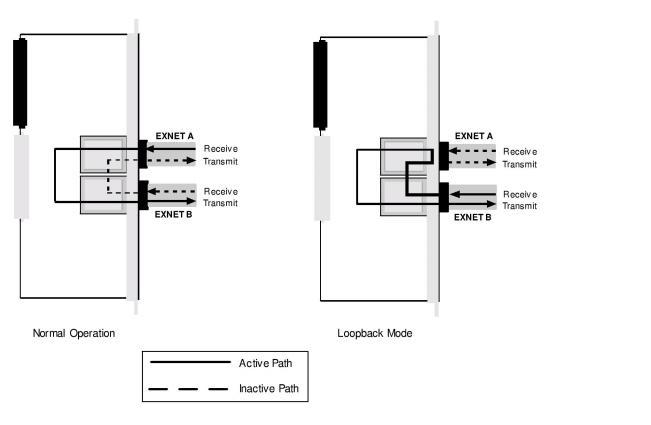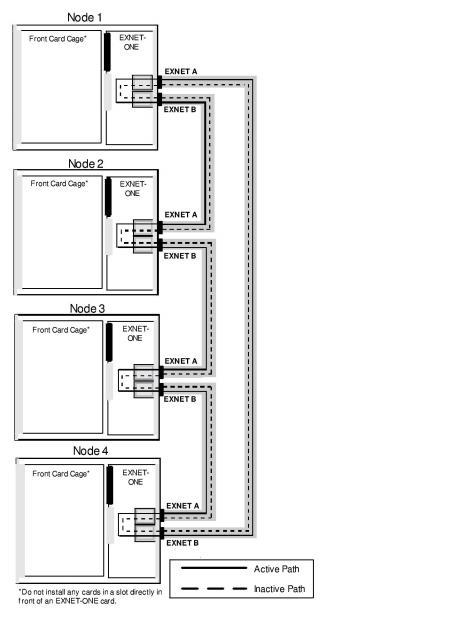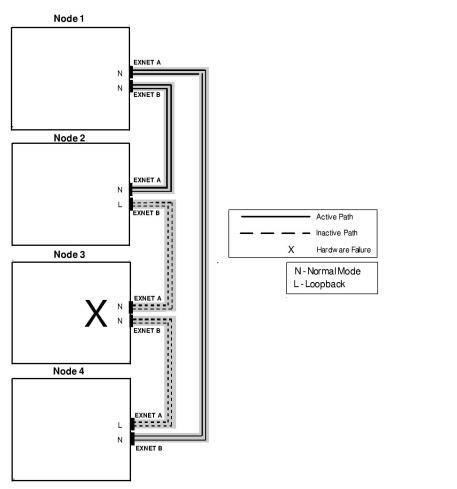
You are here: CSP Hardware Installation and Maintenance > 5 Building a Multi-Node CSP > EXNET® Fault Recovery and Redundancy
EXNET® Fault Recovery and Redundancy

Overview
An EXNET® system is self-healing with hardware failures involving a segment of the EXNET® ring and an EXNET-ONE card. If a failure occurs, a node or ring segment is automatically bypassed as the EXNET® port on the EXNET-ONE card is looped back.
There are no special hardware requirements to enable EXNET® Fault Recovery. Configure the hardware as previously described in this document.
The EXNET® cable is a fiber optic cable with separate cables for transmitting and receiving. During normal operation, the EXNET-ONE card receives packets from the ring through its EXNET Port A and transmits packets onto the ring through its EXNETPort B. In loopback mode, ring traffic is both received and transmitted through the same EXNET® port. The two modes of operation are shown in EXNET-ONE Port Status.
Figure 5-10 EXNET-ONE Port Status

When an EXNET® port is placed in loopback mode, the Fault Detect LEDs turn red and the host receives a Ring Status Report message indicating the status (normal or loopback) of both EXNET® ports on the card.
An EXNET® port cannot be placed in loopback mode by the host. To isolate a node from an CSP system, do one of the following:
1 Take the EXNET-ONE card out of service.
2 Power-down the node.
Normal Ring Operation shows the connection between nodes during normal operation. All nodes are receiving ring traffic on their EXNET A port and transmitting traffic on their EXNET B port.
During normal operation, the Signal Detect and Fault Detect LEDs are green.
Figure 5-11 Normal Ring Operation

Loopback Mode
Loopback Mode shows how EXNET® ports on the EXNET-ONE card are put in loopback mode because of a failure in an EXNET® ring segment.
• The EXNET® ports connected to the failed ring segment (Node 1/EXNET A, Node 4/EXNET B) are placed in loopback mode.
• The traffic on the EXNET-ONE cards is both transmitted and received through one EXNET® port.
• A ring connection is maintained between all nodes, and no calls are dropped.

This section describes what happens when a your system experiences a ring segment failure.
Ring Segment Failure illustrates the ring connection between nodes after the failure of a ring segment in a single ring configuration.
• The node that was connected to the failed segment at its EXNET A port loops back its EXNET A port.
• The node connected to the failed segment at its EXNET B port loops back its EXNET B port.
• A complete ring is maintained between all nodes.The host receives a Ring Status Report message from the affected nodes indicating that the affected EXNET® ports are in loopback mode.
A redundant EXNET® ring configuration has no effect if an EXNET® ring segment fails on one of the rings. The affected ring self-heals and a complete loop is maintained on both rings.
Figure 5-13 Ring Segment Failure

This section describes what happens when your system experiences an EXNET-ONE card failure.
EXNET-ONE Card Failure – Single Ring shows the ring connection between nodes after the failure of an EXNET-ONE card in a single ring configuration.
• The node that was connected to the failed node’s EXNET A port loops back its EXNET B port.
• The node connected to the failed node’s EXNET B port loops back its EXNET A port.
• All calls on the failed node connected across the ring are purged.
• A ring connection is maintained between all remaining nodes. The host receives a Ring Status Report message from the adjacent nodes indicating that the affected EXNET® ports are in loopback mode.
Figure 5-14 EXNET-ONE Card Failure – Single Ring

Important! If the EXNET-ONE card is reset, the EXNET® ring resets when the node rejoins the ring.
If the Master Node fails in a non-redundant system, the EXNET® ring resets and all inter-nodal connections are purged. To determine the Master Node, send a Ring Status Query to each node.
EXNET® Card Failure – Redundant Ring shows the ring connection between nodes after the failure of an EXNET-ONE card in a redundant ring configuration.
Figure 5-15 EXNET® Card Failure – Redundant Ring

• The node that was connected to the failed node’s EXNET A port (Node 2) loops back its EXNET B port on the affected ring
(Ring 1).
• The node that was connected to the failed node’s EXNET B port (Node 4) loops back its EXNET A port on the affected ring
(Ring 1).
• Traffic to and from Node 3 is routed through Ring 2. Traffic on other nodes is still carried on both rings. The host receives a Ring Status Report message from the adjacent nodes indicating that the affected EXNET® ports are in loopback mode.
Important! In this scenario, there is no longer EXNET® Redundancy for Node 3. If the EXNET-ONE card for Ring 2 fails, Node 3 is isolated from the CSP system and all inter-nodal connections involving Node 3 are dropped.